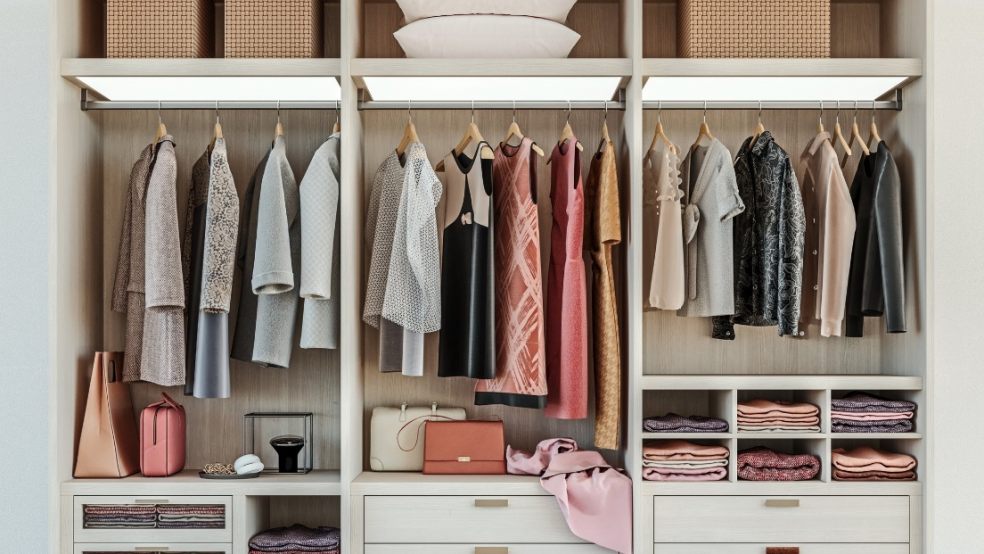
Eight tips for tackling a wardrobe clear-out
Lockdown is undoubtedly difficult and draining, but luckily, there are plenty of creative things to do for entertainment while you’re waiting out the pandemic – like finally tackling those niggly bits of house admin you’ve been putting off.
A good place to start is your wardrobe. A clean, organised, streamlined closet is not only nice to look at, but can offer a little slice of calm amongst the chaos, and inspire you to ditch the sweatpants in favour of wearing something more mood-boosting.
Here are some quick tips and tricks for decluttering your space and sorting your clothes and accessories…
1. Take everything out of your wardrobe
How often have you dug through the pit of clothes in your wardrobe only to find a pair of trousers, jumper or jacket you’d completely forgotten you owned?
The best way to get a proper inventory of everything in your closet is to empty it all out onto the bed. From here, you can group your clothes into categories (jeans, t-shirts, jumpers etc.) ready for a thorough clear-out.
2. Don’t cling to pieces you’ll never wear
If your clothes are so tightly packed in it’s difficult to see what you own, it’s probably a sign you could donate or pass on some pieces.
So what should you get rid of? Think about letting go of items you haven’t worn in the past year; clothes that don’t fit or crease too easily (especially if you have an aversion to ironing); or pieces that are too uncomfortable to enjoy wearing. You could even host a virtual clothes swap and allocate items to friends who’d be happy to take them off your hands once lockdown is over.
3. Pack away clothes that don’t work for the season
Clothes that don’t suit the current season can clutter up precious space in your wardrobe. As we’re approaching the warmer months, it’s an ideal time to box up your thick winter jumpers, coats and boots, and store them elsewhere like a storage facility in Brighton, out of sight. Just don’t accidentally donate them…
4. Organise by category, then colour
Try grouping your clothes by category and then colour. Not only does this make it easier to search for a specific item when you’re getting dressed in a hurry, but also creates a lovely rainbow effect in your closet.
Never again will you have to dig for that sweater that’s mysteriously vanished in the wash…
5. Store occasionwear in another room
Fancier items like suits and cocktail dresses need to be on hangers to keep their shape, but the chances of you reaching for them regularly are slim. Think about hanging these in another room – maybe even the coat closet – to free up space in your everyday wardrobe.
6. Fold your knitwear
Fabrics like wool, cashmere, and angora can be stretched and damaged on hangers, so it’s always best to fold your jumpers to keep them in mint condition. If you don’t have a set of drawers to place them in, think about investing in some extra in-wardrobe storage, like a hanging fabric organiser.
7. Invest in coordinating hangers
Hangers can be a total pain because they get tangled up with one another. Or worse, they’re not the right size for your clothes, so your delicate items slide to the floor every time you grab for them.
Invest in a set of sturdy hangers. Velvet hangers are a great choice for silky items like dresses and camisoles, and they take up less space than wood versions. Try to avoid wire hangers too. Although they’re often cheaper, they can cause your clothes to lose their shape over time.
8. Make use of vertical space
If the idea of sifting through the bottom of your wardrobe fills you with dread, the inside of your wardrobe doors might be ideal for hanging all those accessories and shoes that tend to get dumped on the floor.
Add some pegs for hanging scarves, bags and belts, or simply attach an inexpensive fabric shoe organiser (which should help limit how many shoes you own too).
Finally, make sure you keep on top of the contents of your wardrobe. Schedule regular organising days, or even operate a ‘one in one out’ policy, to ensure it remains a clutter-free space.
Image: Getty Images/iStockphoto













